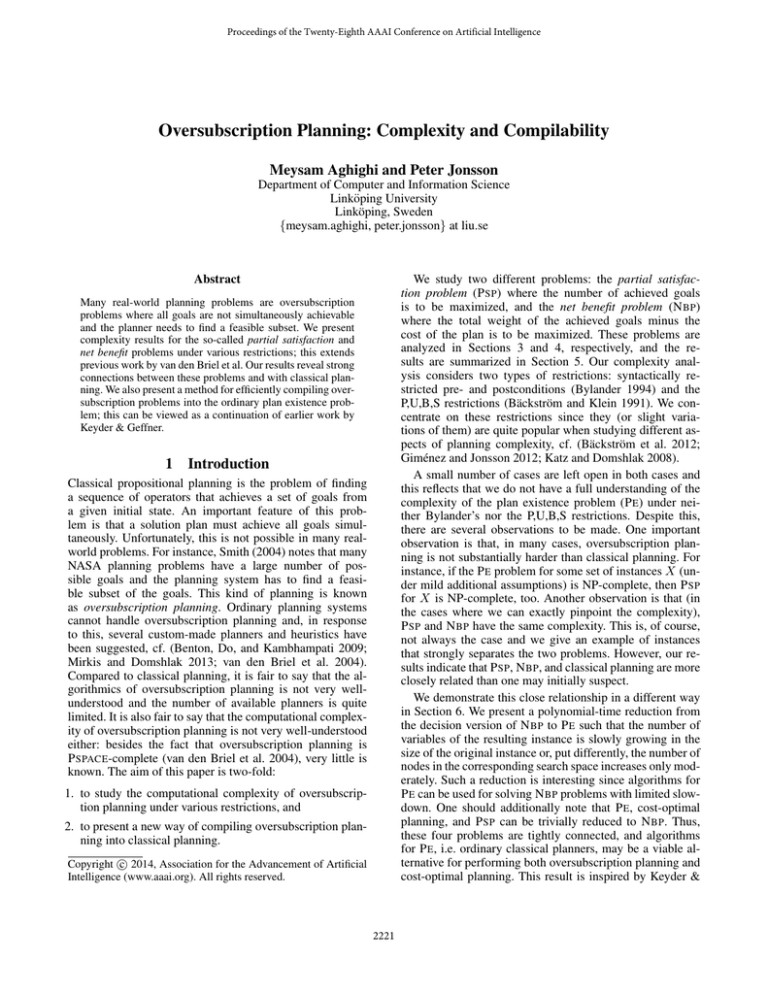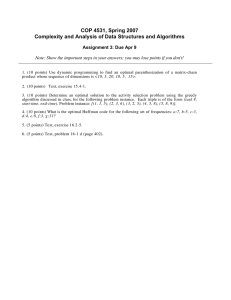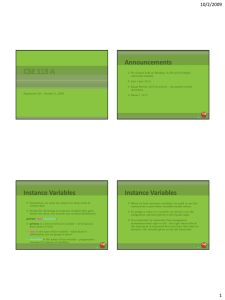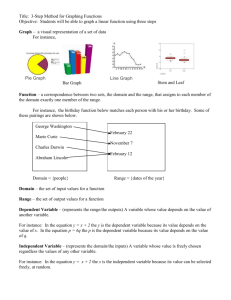
Proceedings of the Twenty-Eighth AAAI Conference on Artificial Intelligence
Oversubscription Planning: Complexity and Compilability
Meysam Aghighi and Peter Jonsson
Department of Computer and Information Science
Linköping University
Linköping, Sweden
{meysam.aghighi, peter.jonsson} at liu.se
Abstract
We study two different problems: the partial satisfaction problem (P SP) where the number of achieved goals
is to be maximized, and the net benefit problem (N BP)
where the total weight of the achieved goals minus the
cost of the plan is to be maximized. These problems are
analyzed in Sections 3 and 4, respectively, and the results are summarized in Section 5. Our complexity analysis considers two types of restrictions: syntactically restricted pre- and postconditions (Bylander 1994) and the
P,U,B,S restrictions (Bäckström and Klein 1991). We concentrate on these restrictions since they (or slight variations of them) are quite popular when studying different aspects of planning complexity, cf. (Bäckström et al. 2012;
Giménez and Jonsson 2012; Katz and Domshlak 2008).
A small number of cases are left open in both cases and
this reflects that we do not have a full understanding of the
complexity of the plan existence problem (P E) under neither Bylander’s nor the P,U,B,S restrictions. Despite this,
there are several observations to be made. One important
observation is that, in many cases, oversubscription planning is not substantially harder than classical planning. For
instance, if the P E problem for some set of instances X (under mild additional assumptions) is NP-complete, then P SP
for X is NP-complete, too. Another observation is that (in
the cases where we can exactly pinpoint the complexity),
P SP and N BP have the same complexity. This is, of course,
not always the case and we give an example of instances
that strongly separates the two problems. However, our results indicate that P SP, N BP, and classical planning are more
closely related than one may initially suspect.
We demonstrate this close relationship in a different way
in Section 6. We present a polynomial-time reduction from
the decision version of N BP to P E such that the number of
variables of the resulting instance is slowly growing in the
size of the original instance or, put differently, the number of
nodes in the corresponding search space increases only moderately. Such a reduction is interesting since algorithms for
P E can be used for solving N BP problems with limited slowdown. One should additionally note that P E, cost-optimal
planning, and P SP can be trivially reduced to N BP. Thus,
these four problems are tightly connected, and algorithms
for P E, i.e. ordinary classical planners, may be a viable alternative for performing both oversubscription planning and
cost-optimal planning. This result is inspired by Keyder &
Many real-world planning problems are oversubscription
problems where all goals are not simultaneously achievable
and the planner needs to find a feasible subset. We present
complexity results for the so-called partial satisfaction and
net benefit problems under various restrictions; this extends
previous work by van den Briel et al. Our results reveal strong
connections between these problems and with classical planning. We also present a method for efficiently compiling oversubscription problems into the ordinary plan existence problem; this can be viewed as a continuation of earlier work by
Keyder & Geffner.
1
Introduction
Classical propositional planning is the problem of finding
a sequence of operators that achieves a set of goals from
a given initial state. An important feature of this problem is that a solution plan must achieve all goals simultaneously. Unfortunately, this is not possible in many realworld problems. For instance, Smith (2004) notes that many
NASA planning problems have a large number of possible goals and the planning system has to find a feasible subset of the goals. This kind of planning is known
as oversubscription planning. Ordinary planning systems
cannot handle oversubscription planning and, in response
to this, several custom-made planners and heuristics have
been suggested, cf. (Benton, Do, and Kambhampati 2009;
Mirkis and Domshlak 2013; van den Briel et al. 2004).
Compared to classical planning, it is fair to say that the algorithmics of oversubscription planning is not very wellunderstood and the number of available planners is quite
limited. It is also fair to say that the computational complexity of oversubscription planning is not very well-understood
either: besides the fact that oversubscription planning is
P SPACE-complete (van den Briel et al. 2004), very little is
known. The aim of this paper is two-fold:
1. to study the computational complexity of oversubscription planning under various restrictions, and
2. to present a new way of compiling oversubscription planning into classical planning.
c 2014, Association for the Advancement of Artificial
Copyright Intelligence (www.aaai.org). All rights reserved.
2221
have restriction B). For example, by SAS+ -B12+ , we mean
P E for instances having |D| = 2 and allowing at most one
precondition and two positive postconditions per action.
When dealing with two-valued domains, we always assume that D = {0, 1} and we use a simplified way of defining actions. We write x̄ to denote that variable x has (or is
assigned) value 0. Then we may simply write x, ȳ → z when
referring to the action having preconditions x = 1, y = 0
and postcondition z = 1. If an action has no preconditions, then this is indicated with the symbol ∅. Finally, we
let Y = {ȳ | y ∈ Y }.
Geffner (2009) who have presented a method for compiling
the optimization version of N BP into cost-optimal planning.
2
Planning Framework
+
We use the SAS planning framework (Bäckström and
Nebel 1995) as our basic formalism. A SAS+ planning instance is a tuple Π = (V, A, I, G) where V = {v1 , . . . , vn }
is the set of variables over a finite domain D. We add a value
u to D (where u stands for undefined) resulting in the set
n
D+ . Dn is the set of total states and D+
is the set of parn
tial states. The value of a variable v in a state s ∈ D+
is
denoted as s[v], and we let hsi = |{v ∈ V | s[v] 6= u}|.
n
I ∈ Dn is the initial state and G ∈ D+
is the goal state.
A is the set of actions where every action a ∈ A has a pren
n
condition pre(a) ∈ D+
and a postcondition post(a) ∈ D+
.
For two states s1 , s2 , we write s1 v s2 if and only if for all
v ∈ V , either s1 [v] = u or s1 [v] = s2 [v]. An action a is
applicable in a state s ∈ Dn if and only if pre(a) v s. The
result of a in s, if a be applicable in s, is a state t ∈ Dn such
that for all v ∈ V , t[v] = s[v] if post(a)[v] = u, otherwise
t[v] = post(a)[v]. We say action a affects variable v in state
s, if s[v] 6= t[v] where t is the result of a in s.
n
, a sequence of
Given two states I ∈ Dn and G ∈ D+
actions ω = (a1 , . . . , am ) is called a plan from I to G if and
only if there exists a sequence of total states (s1 , . . . , sm−1 )
such that s1 is the result of a1 in I, si is the result of ai in
si−1 for all 2 ≤ i ≤ m − 1, and G v sG where sG is the
result of am in sm−1 .
Let Θ be an arbitrary set of SAS+ instances. The SAS+
plan existence problem P E(Θ) has the following definition:
I NSTANCE : A SAS+ instance Π = (V, A, I, G) ∈ Θ.
Q UESTION : Does Π have a solution, i.e. a plan from I to G?
We will also consider the bounded cost plan existence
problem (B CPE(Θ)):
I NSTANCE : A tuple Π = (V, A, I, G, c, K) where
(V, A, I, G) ∈ Θ, c is a function assigning a non-negative
integer weight to each a ∈ A, and K is an integer.
Q UESTION : Does Π have a solution (a1 , . . . , an ) such that
P
n
i=1 c(ai ) ≤ K?
For historical reasons (but also notational convenience),
we will sometimes use a different notation for restricted SAS+ instances. Consider the following restrictions
(Bäckström and Klein 1991) on instances (V, A, I, G):
P: (Post-unique) for every v ∈ V and every d ∈ D, there is
at most one a ∈ A such that post(a)[v] = d.
U: (Unary) for every a ∈ A, hpost(a)i = 1.
B: (Binary) |D| = 2.
S: (Single-valued) for every v ∈ V and every a, b ∈
A, if pre(a)[v] 6= u, pre(b)[v] 6= u and post(a)[v] =
post(b)[v] = u, then pre(a)[v] = pre(b)[v].
We write P E-R to denote the P E problem restricted to instances satisfying the restrictions in R, i.e. P E-PU means
P E(Θ) where Θ contains all instances satisfying restrictions
P and U. We also study another type of restrictions (introduced by Bylander (1994)) which is based on restricting the
sign and number of preconditions and postconditions of actions (the sign restriction is only discussed when we already
3
The Partial Satisfaction Problem
Let Θ denote a set of SAS+ instances. The partial satisfaction problem P SP(Θ) has the following definition:
I NSTANCE : A tuple (V, A, I, G, K) where (V, A, I, G) ∈ Θ
and K is a positive integer.
Q UESTION : Is there a state G0 v G such that hG0 i ≥ K and
(V, A, I, G0 ) has a solution?
We define the P SP problem as a decision problem which
allow us to simplify the forthcoming proofs. Viewing it as
an optimization problem instead does not affect the complexity substantially: a decision problem in P will have a
corresponding optimization problem in FP (the functional
analogue of P), an NP-complete decision problem will have
an optimization problem in FPNP (by using binary search),
and a P SPACE-complete decision problem will have an optimization problem in F PSPACE. Furthermore, we use integer
values instead of rational values. Rational values can easily
be replaced by integers via multiplication with suitable factors, and this reformulation leads to an equivalent instance
whose size is only marginally larger. These observations also
apply to the N ET B ENEFIT problems that we will introduce
later on.
Note that P E(Θ) can be viewed as an instance of P SP(Θ)
(simply by setting K = hGi) and recall that P SP(Θ) is in
P SPACE (van den Briel et al. 2004)). We say that Θ is closed
under goal substitution if for arbitrary (V, A, I, G) ∈ Θ, all
|V |
instances (V, A, I, G0 ) such that G0 ∈ D+ are members of
Θ. Clearly, the sets of instances satisfying the P,U,B,S and/or
Bylander’s restrictions are closed under goal substitution.
Lemma 1. Let Θ be a set of SAS+ instances that is closed
under goal substitution. If P E(Θ) ∈ NP, then P SP(Θ) ∈ NP.
Proof. Let Π0 = (V, A, I, G, K) be an arbitrary instance
of P SP(Θ). Nondeterministically guess a state G0 v G
such that hG0 i ≥ K. We know that (V, A, I, G0 ) is an
instance of P E(Θ), too. Hence, we can nondeterministically guess a polynomially bounded certificate X showing
that (V, A, I, G0 ) is solvable. It follows that (X, G0 ) is a
polynomial-time verifiable certificate for Π0 .
Thus, there is a close connection between P E(Θ) and
P SP(Θ): if Θ is closed under goal substitution and P E(Θ) is
NP- or P SPACE-complete, then P SP(Θ) is NP- or P SPACEcomplete, respectively. We can now concentrate on instance
sets Θ such that P E(Θ) is solvable in polynomial time.
1+
0
Theorem 1. P SP-B2+
and P SP-B1+
are NP-hard.
2222
0
Proof. We begin with P SP-B2+
. The proof is by a
polynomial-time reduction from the NP-complete problem
V ERTEX C OVER, (Garey and Johnson 1979, GT1):
I NSTANCE : Graph G = (V, E) and integer K ≤ |V |.
Q UESTION : Is there a vertex cover of size K or less for G,
i.e., a subset V 0 ⊆ V with |V 0 | ≤ K such that for each edge
{u, v} ∈ E at least one of u and v belongs to V 0 ?
Assume that we have an instance (V, E, K) of V ERTEX
C OVER where V = {v1 , . . . , vn }, E = {e1 , . . . , em } ⊆
V 2 , and 0 ≤ K ≤ |V|. Define a P SP-B02+ instance Π =
(V, A, I, G, K 0 ) as follows: V = {v1 , . . . , vn } ∪ {elj |1 ≤
j ≤ m, 0 ≤ l ≤ 1}, I = (0, . . . , 0), K 0 = 2m + n − K,
and G[vi ] = 0 for every 1 ≤ i ≤ n. Furthermore, for every
0 ≤ l ≤ 1 and every 1 ≤ j ≤ m such that ej = (u, w) ∈ E,
let G[elj ] = 1 and let A contain the actions alj : ∅ → elj , u
and blj : ∅ → elj , w.
Assume Π has a solution ω and, additionally, assume that
ω achieves the highest possible number of goals. Let t and s
be the number of vi and elj variables that are equal to 1, respectively, in the state sG resulting from applying ω to I. We
first show that sG [elj ] = 1 for all i, j and, consequently, that
s = 2m. Assume to the contrary that sG [elj ] = 0 for some
l
l, j. If sG [e1−l
j ] = 1, then we can set ei to 1, too, by using
l
l
either the action aj or bj . Note that this can be done without assigning the value 1 to any additional vi variables. This
new plan achieves a strictly higher number of goals which
contradicts the choice of ω.
If sG [e0j ] = sG [e1j ] = 0, then we can set both of them
to 1 by using actions a0j and a1j . This gives us two new
satisfied goals and, possibly, one less vi variable satisfying
its goal. All in all, this new plan achieves a strictly higher
number of goals which once again contradicts the choice of
ω. Hence, all elj variables can be assumed to have value 1
and s = 2m. Finally, note that n − t is the number of vi
variables that are given the value 0 and, thus, contribute to
the number of satisfied goals. It follows that s + n − t ≥
K 0 ⇒ 2m + n − t ≥ 2m + n − K ⇔ t ≤ K. Consequently,
(V, E, K) has a solution.
If (V, E, K) has a solution V 0 ⊆ V, then let
A0 = {a1 , . . . , ap } contain the actions a ∈ A satisfing
post(a)[v 0 ] 6= u for some v 0 ∈ V 0 . Let ω = (a1 , . . . , ap ) and
note that ω is applicable in I. Furthermore, it will achieve at
least 2m + n − K goals.
The proof for P SP-B1+
1+ is virtually identical: the only major difference is that we replace actions of the type alj :
∅ → elj , u with the two actions ∅ → u and u → elj , and we
do an analogous replacement for blj actions.
Assume that (V, E, K) is an instance of I NDEPENDENT
S ET where V = {v1 , . . . , vn }. We define an instance of P SPPUBS+ Π = (V, A, I, G, K) as follows: V = {v1 , . . . , vn },
A = {a1 , . . . , an }, I = (0, . . . , 0), G = (1, . . . , 1), and for
every vi ∈ V we define ai : v i1 , . . . , v it → vi where
vi1 , . . . , vit are the neighbours of vi . It is straightforward to
verify that this instance is an instance of P SP-PUBS+ .
Let {vi1 , . . . , vip } ⊆ V be a solution to (V, E, K). We
immediately see that (ai1 , . . . , aip ) is a solution to Π; merely
note that once a vertex vi has been selected (by inserting ai
into the plan), all of its neighbours are ‘blocked’ from further consideration by the choice of preconditions. Similarly,
if Π has a solution (ai1 , . . . , aip ), then {vi1 , . . . , vip } is a
solution to (V, E, K).
4
The Net Benefit Problem
n
Given a goal state G ∈ D+
and a utility vector U ∈ Nn0
(where N0 denotes
P the set of non-negative integers), we let
mG,U (S) =
{U [i] | S[i] = G[i] 6= u}, i.e. mG,U (S)
denotes the total utility of a state S given a goal state G and
the utilities of the components of G. Let Θ denote a set of
SAS+ instances. The net benefit problem N BP(Θ) has the
following definition:
I NSTANCE :
A tuple (V, A, I, G, c, U, K) where
(V, A, I, G) ∈ Θ, c is a function from A to N0 , U ∈ Nn0 ,
and K is a positive integer.
Q UESTION : Is there a plan p = (a1 , . . . , at ) starting from IP and leading to a state S such that
t
mG,U (S) − i=1 c(ai ) ≥ K?
Pt
The value mG,U (S) − i=1 c(ai ) is called the net benefit
of the plan p. Note that N BP always has a solution with net
benefit ≥ 0: the empty plan. P SP(Θ) is trivially polynomialtime reducible to N BP(Θ) by letting the action cost function
c always return 0 and choosing U = {1}n . We next prove
that there is a connection between B CPE and N BP that is
analogous to the connection between P E and P SP established
in Lemma 1.
Lemma 2. Let Θ be a set of SAS+ instances that is closed
under goal substitution. If B CPE(Θ) ∈ NP, then N BP(Θ) ∈
NP.
Proof. Let Π = (V, A, I, G, c, U, K) be an arbitrary instance of N BP(Θ). Nondeterministically guess
(1) two numbers υ, γ ∈ N0 such that υ − γ ≥ K,
(2) a state S such that mG,U (S) ≥ υ, and
(3) a certificate X showing that therePexists a plan ω =
n
(a1 , . . . , an ) for (V, A, I, S) with γ ≥ i=1 c(ai ).
X exists for some guess of S and can be verified in polynomial time since B CPE(Θ) is in NP. Hence, (υ, γ, S, X)
exists if and only if Π has a solution, and the certificate
(υ, γ, S, X) can be verified in polynomial time.
Theorem 2. P SP-PUBS+ is NP-hard.
Proof. Proof by reduction from the NP-complete problem
I NDEPENDENT S ET, (Garey and Johnson 1979, GT20):
I NSTANCE : Graph G = (V, E) and integer K ≤ |V |.
Q UESTION : Does G contain an independent set of size K or
more? i.e., a subset V 0 ⊆ V such that |V 0 | ≥ K and such
that no two vertices in V 0 are joined by an edge in E.
We are now ready to prove the necessary complexity results for N BP. We begin with a tractability result.
Theorem 3. N BP01 is in P.
Proof. Let Π = (V, A, I, G, c, U, K) be an arbitrary instance of N BP01 . Let A0 contain those actions that achieves
2223
some component of the goal G, and if there are multiple actions for the same component, then pick one action with the
lowest cost according to function c. Finally, let {a1 , . . . , an }
denote the actions a ∈ A0 satisfying u − c(a) > 0 where u
is the utility of the goal achieved by a. Let S be the state resulting from applying (a1 , . . . , an ) toP
I. It is clear that Π has
n
a solution if and only if mG,U (S) − i=1 c(ai ) ≥ K.
None of the values in Xv equals yv . We claim that no action appears more than one time in ωv . Assume to the contrary that for some i < j, the action ai is the same as action
aj . Then, the subsequence (ai , ai+1 , . . . , aj−1 ) produces v
values that are not needed in the precondition of any other
actions or the goal. Recall that these actions only affect variable v (due to restriction U) so we can simply remove them
from ωv . This results in a plan with either lower cost or
shorter length than ω which leads to a contradiction.
At least two of the values in Xv equal yv . If xi = xj =
yv for some i < j, then we can delete actions
(ai+1 , . . . , aj−1 , aj ) from ωv — the reason behind this is
similar to the previous case. Hence, this cannot occur.
Exactly one value in Xv equals yv . Assume that xi =
yv and divide ωv into ωv1 = (a1 , . . . , ai−1 ) and ωv2 =
(ai+1 , . . . , ak ). In each part, every action can appear at most
once since, otherwise, the actions between the two occurrences can be deleted (once again in a fashion similar to the
first and second cases) and this results in a cheaper and/or
shorter plan. This leads to a contradiction so every action
appears at most two times in ωv .
By restriction U, every action appears in at most one of
the ωv sequences which implies, by the three cases above,
that each action in A appears at most two times in ω.
Next, we prove that certain N BP problems are members of
NP by showing that the corresponding B CPE problems are
in NP and using Lemma 2. The complexity of finding shortest solutions for these problems is well-studied (Bäckström
and Nebel 1995; Bylander 1994) but we need results for arbitrarily weighted actions. Given a solvable instance Π =
(V, A, I, G, K) of B CPE, let S(Π) contain the solutions to
Π with lowest possible cost and let S 0 (Π) contain the members of S(Π) having minimum length.
Theorem 4. N BP0 is in NP.
Proof. We show that B CPE0 is in NP and use Lemma 2. Let
Π = (V, A, I, G, c, K) be an arbitrary solvable instance of
B CPE0 and arbitrarily choose ω ∈ S 0 (Π). We claim that
every action in ω occurs at most once and, consequently,
that |ω| ≤ |A| and B CPE0 is NP since we can simply list
the actions in the plan. Assume to the contrary that there is
an action a that occurs in ω more than once. Construct a
new plan ω 0 by deleting all occurrences of a except the last
one. Clearly, ω 0 is still a plan from I to G: the actions in A
have no preconditions so the removal of a will not affect the
applicability of other actions. If c(a) > 0, then the total cost
of ω 0 is strictly lower than the total cost of ω which leads to
a contradiction. If c(a) = 0, then ω 0 and ω have the same
cost but |ω 0 | < |ω| which leads to a contradiction, too.
5
Summary of Complexity Results
We will now summarize the complexity results for P SP and
N BP. To do so, we need a few more hardness results.
Theorem 7. (Bäckström and Nebel 1995; Bylander 1994)
P E-B1+ , P E-B1 , P E-B2+
2 , P E -UB, and P E -BS are P SPACE complete problems.
Bylander (1994) does not explicitly state that P E-B1+
is P SPACE-complete but it is a direct consequence of his
P SPACE-completeness proof for P E-B1 . The complexity results for P SP and N BP under Bylander’s restrictions can be
found in Tables 1–4. The “*” symbol means that there is
no restriction on the number of pre- or postconditions while
‘≥ 2’ implies that the result holds for any fixed number ≥ 2.
The tables also contain information about the P E problem
from (Bäckström and Nebel 1995; Bylander 1994): the symbol ‘†’ indicates when we know for sure (under the assumption P 6= NP) that the complexity of P E differs from the complextiy of P SP and N BP. The difference is always the same,
namely, the P E problem is in P while the oversubscription
problem is NP-complete. One sees that the complexity of P E
and oversubscription planning only differs in a small number of ‘borderline’ cases.
The results can be inferred as follows: both P SP and N BP
problem are members of P SPACE (van den Briel et al. 2004).
P SPACE-hardness follows from Theorem 7 combined with
the fact that P E(Θ) polynomial-time reduces to P SP(Θ) and
N BP(Θ) for all Θ. NP-hardness follows from the results in
Section 3 — recall that if P SP(Γ) is NP-hard, then N BP(Γ) is
NP-hard, too. The NP membership results is shown in Section 4 — note that if N BP(Θ) is in NP, then P SP(Θ) is in NP,
too. Finally, the tractability results follow from Theorem 3.
Results for the P,U,B,S restrictions are collected in Figure 1.
Theorem 5. N BP-B+ is in NP.
Proof. We show that B CPE-B+ is in NP and use Lemma 2.
Let Π = (V, A, I, G, c, K) be an arbitrary solvable instance
of B CPE-B+ and arbitrarily choose ω ∈ S 0 (Π). Each action
in ω changes at least one variable from 0 to 1 and no action
changes it back. Hence, |ω| ≤ |V | and we are done.
Theorem 6. N BP-US and N BP-B+
1 are in NP.
Proof. We show that N BP-US is in NP; this immediately implies that N BP-B+
1 is in NP, too. By Lemma 2, it is sufficient
to prove that B CPE-US is in NP. Let Π = (V, A, I, G, c, K)
be an arbitrary solvable instance of B CPE-US and arbitrarily choose ω = (a1 , . . . , at ) ∈ S 0 (Π). We claim that every
action appears at most twice in ω and that |ω| ≤ 2|A|. For
every v ∈ V , let ωv = (a1 , . . . , ak ) denote the subsequence
of ω containing those actions changing variable v, and let
Xv = (x0 , x1 , x2 , . . . , xk ) be defined such that x0 = I[v]
and pre(ai )[v] = xi−1 , post(ai )[v] = xi for 1 ≤ i ≤ k.
Since Π satisfies restriction S, we know that for every v ∈ V
and every a, b ∈ A, if pre(a)[v] 6= u, pre(b)[v] 6= u and
post(a)[v] = post(b)[v] = u, then pre(a)[v] = pre(b)[v].
Let yv denote this unique ‘prevail’ value for v if it exists and
let yv = u otherwise. Arbitrarily choose v ∈ V and consider
the following three cases:
2224
Table 3: Results for free prec. / + postc.
+ post
1
≥2
∗
0
P
NP-c. † NP-c. †
1
NP-c.
NP-c.
NP-c.
≥ 2 NP-c.
NP-c.
NP-c.
∗
NP-c.
NP-c.
NP-c.
pre
pre
Table 1: Results for P SP and N BP
post
1
≥2
∗
0
P
NP-c. †
NP-c. †
1
NP-h.
NP-h.
P SPACE-c.
≥2
NP-h.
P SPACE-c. P SPACE-c.
∗
P SPACE-c. P SPACE-c. P SPACE-c.
Table 4: Results for + prec. / + postc.
Unrestricted
PU
P
U
S
B
PS
PB
US†
UB
PUB
PBS
UBS†
+ pre
PSPACE-C
Figure 1: Results for P,U,B,S restrictions
These results and the results in Table 1 hold for arbitrary domains D satisfying |D| ≥ 2. Tables 2–4 contain results for
two-valued domains where we restrict ourselves to positive
pre- and/or postconditions. Once again, the complexity of
P SP and N BP coincide in all cases.
It may be slightly surprising that the P SP and N BP problems have the same complexity but this is inherent in the
restrictions we consider. Of course, this is not true for all instance sets: Jonsson (1999, Sec. 4) shows that there is a set
Θ of planning instances that (1) always have a solution but
(2) finding the shortest solution is P SPACE-hard. (1) implies
that P SP(Θ) is trivially solvable in polynomial time while
(2) implies that N BP(Θ) is P SPACE-complete.
an1
an2
Compiling N BP into P E
ank−n
We continue by presenting a method to compile N BP into
P E. The basic motivation behind this reduction is to provide a method for using ordinary planners for solving the
N BP problem. Our main concern is to make the reduction as
lean as possible, i.e. we want the reduction to increase the
size of the resulting instance as little as possible. The previously presented complexity results cannot be inferred from
+ pre
∗
NP-c. †
NP-c.
NP-c.
NP-c.
this reduction since it is not guaranteed to preserve any of
the properties except B.
The method is based on a certain kind of counter which
we introduce next. The counter is very important in the reduction since it is used for keeping track of the net benefit during the course of the plan. Given an integer 0 ≤ m,
we let (mn−1 . . . m1 m0 )2 denote m written in binary where
mn−1 is the most significant bit and m0 the least significant.
Given a sequence of binary variables X = (xn−1 , . . . , x0 ),
we can easily use such a sequence to represent the number
m: let xi = 1 if mi = 1 and xi = 0, otherwise. Define
(X l m) = {xi | mi = 1} ∪ {x̄i | mi = 0}. For instance,
if X = (x2 , x1 , x0 ), the action (X l 3) → (X l 5) equals
x̄2 , x1 , x0 → x2 , x̄1 , x0 . Given a state S over variable sequence X, we let JSK denote the number that X represents.
Let X = (xk−1 , . . . , x0 ) be a sequence of variables. If
0 ≤ n < k and JXK < 2k − 2n , then X is transformed into
a new state X 0 such that JX 0 K = JXK + 2n by exactly one
of the following k − n actions:
PUBS†
6
+ post
≥2
NP-c. †
NP-c.
NP-c.
NP-c.
BS
NP-H
NP-C
PUS†
0
1
≥2
∗
1
P
NP-c. †
NP-c. †
NP-c. †
: x̄n → xn
: x̄n+1 , xn → xn+1 , x̄n
..
.
: x̄k−1 , xk−2 , . . . , xn → xk−1 , x̄k−2 , . . . x̄n
We use these actions to build a counter with arbitrary step
size and the ability to count both upwards and downwards.
Arbitrarily choose an integer 0 ≤ x < 2k and a step
length 0 ≤ s < 2k . Introduce ‘upward trigger’ variables
C = {ci | 0 ≤ i < k}, ‘downward trigger’ variables
D = {di | 0 ≤ i < k}, and for every 0 ≤ i < k and
1 ≤ l ≤ k − i, introduce actions
Table 2: Results for + prec. / free postc.
post
1
≥2
∗
0
P
NP-c. †
NP-c. †
1
NP-c. †
NP-h.
P SPACE-c.
≥ 2 NP-c. † P SPACE-c. P SPACE-c.
∗
NP-c. † P SPACE-c. P SPACE-c.
incil
: ci , pre(ail ) → ci , post(ail )
decil
: di , post(ail ) → di , pre(ail )
Consider a planning instance (V, A, I, G) where V = X ∪
C ∪D, A contains the actions above, I specifies the values of
the X variables such that JI[X]K = x, the C variables equal
C l s and the D variables equal 0. Finally, let G[v] = u for
v ∈ X ∪ D and G[v] = 0 for v ∈ C. It is not hard to see that
2225
this instance has a solution and it reaches a state S where
JS[X]K = x + s. Similarly, if we want to lower X with s
steps, we use the downward trigger variables in D instead
of C. Note that if the X and D variables are representing
numbers x and d such that x < d, then the counter cannot
set all D variables to 0: this way, underflows can be detected
and prevented.
We now use the counter for compiling N BP into P E. Given
an instance I = (V, A, I, G, c, U, K) of N BP, we construct
an instance of P E where we have a global counter (to keep
track of the net benefit) over variables X. Initially, X is
P|V |
loaded with the value M = i=1 U [i], i.e. the highest possible net benefit. This is done in order to avoid negative numbers. Each action in the plan decreases the counter with its
corresponding weight. If the value goes below 0, then the
N BP instance has no solution. After having found a plan with
total cost γ, we increase the counter with the total utility υ
achieved by this plan. At this point, the counter has value
M − γ + υ and we want to check whether this value is larger
or equal to M + K (in order to verify that υ − γ ≥ K). This
is done by allowing ‘free’ decreasing of the counter until
reaching the goal value M + K.
Construction 1. Let Π = (V, A, I, G, c, U, K) be an instance of N BP such that A = {a1 , . . . , ap }. Construct a
SAS+ instance Π0 = (V 0 , A0 , I 0 , G0 ) as follows: let M =
P|V |
i=1 U [i] and m = [log M ] + 1. We will use a counter
over variables X, C, D on m bits in the construction. Define V 0 = V ∪ X ∪ C ∪ D ∪ B ∪ E where B = {bi |1 ≤
i ≤ [log |A|] + 1} are variables used to prevent action interference and E = {endg |G[g] 6= u} are variables used to
guarantee that after starting to count the utility of the goals,
no other action is applicable. Also, I 0 [v] = I[v] for v ∈ V ,
I 0 [xi ] = pi for 1 ≤ i ≤ m where M = (pm . . . p1 )2 , and
I 0 [v] = 0 otherwise. G0 [xi ] = qi for 1 ≤ i ≤ m where
M + K = (qm . . . q1 )2 , and G0 [v] = u otherwise. We define
A0 as follows: for every ai ∈ A, extend A0 with
a0i
: pre(ai ), B, E → (B l i), (D l c(ai )) and
a00i
:
ω = (a1 , . . . , ar ) and that it satisfies the goals for variables
v1 , . . . , vs (for simplicity). It can be seen that
ω0
7
Discussion
In the first part of this paper, we presented complexity results for the P SP and N BP problems. Clearly, there are many
complexity issues in connection with oversubscription planning that are worth studying. One example is to consider
instances with restricted causal graphs. Classical planning
problems for such instances have been intensively studied (Brafman and Domshlak 2003; Chen and Giménez 2010;
Katz and Domshlak 2008). In particular, it is interesting to see that the structure of the causal graph can be
exploited to identify tractable B CPE problems (Katz and
Domshlak 2008). This suggests that tractability results for
N BP may be obtained this way, too. Another relevant topic
is to study the parameterized complexity of oversubscription planning. Lately, many parameterized complexity results for planning have appeared (Bäckström et al. 2012;
de Haan, Roubı́cková, and Szeider 2013; Kronegger, Pfandler, and Pichler 2013)
In the second part of the paper, we presented a way of
compiling N BP into P E. Both compiling different planning
problems into each other (Keyder and Geffner 2009; Palacios and Geffner 2009; Taig and Brafman 2013) and compiling planning into other problems (Cashmore, Fox, and
Giunchiglia 2012; van den Briel and Kambhampati 2005;
Kautz and Selman 1992) have been very active research areas for quite some time. It is both exciting and slightly surprising to see that competetive planning algorithms result
from compilation: for instance, Keyder & Geffner (2009)
report encouraging results for benchmark oversubscription
problems from the 2008 IPC competition. Experimental
evaluation of our compilation method is an obvious direction for future research. In particular, using it to solve costoptimal planning with the aid of ordinary, non-optimizing
planners is an interesting possibility. One should also note
that the compilation method can be extended in different directions: for instance, modifying it to handle negative utilities is straightforward.
(B l i), D → B, post(ai ).
: B, endvi , C, (vi = G[vi ]) → endvi , (C l U [vi ])
Finally, add the following actions to A0 :
freesubtractl
(a01 , ∆1 , a001 , a02 , ∆2 , a002 , . . . , a0r , ∆r , a00r ,
g10 , ∇1 , g20 , ∇2 , . . . , gs0 , ∇s , ∆)
is a solution for Π0 where ∆i is a sequence of actions decreasing the counter initiated by a0i , ∇j is a sequence of actions increasing the counter initiated by gj0 , and ∆ is a sequence of freesubtract actions that decrease the counter by
net benefit of ω minus K. Since ω is a solution for Π with
net benefit at least K, ω 0 is applicable and the counter value
right before applying ∆ actions is at least M + K. Note that
the minimum and maximum value of the counter are always
kept in the interval [0, 2M ] that the counter covers.
The other direction is similar and thus omitted.
For every vi ∈ V such that G[vi ] 6= u, extend A0 with
gi0
=
: post(a0l ) → pre(a0l ), 1 ≤ l ≤ m.
We note that the instance built in Construction 1 can easily be constructed in polynomial-time and that the size of
the instance increases slowly compared to the size of the
original N BP instance. Since |X| = |C| = |D| = m,
|B| = log |A| and |E| = |G|, the total number of variables
in Π0 is |V 0 | = |V | + 3m + log |A| + |G|. Here, one should
recall that |A| ≤ (|D| + 1)|V | · (|D| + 1)|V | , implying that
log |A| ≤ 2|V | log (|D| + 1), and that m is the logarithm of
the sum of the utility vector U .
Theorem 8. Construction 1 is a reduction from N BP to P E.
Acknowledgements
0
Proof. Let Π be an instance of N BP and let Π be the P E instance obtained via Construction 1. Assume Π has a solution
Meysam Aghighi is partially supported by the National
Graduate School in Computer Science (CUGS), Sweden.
2226
References
Smith, D. 2004. Choosing objectives in over-subscription
planning. In Proc. 14th International Conference on Automated Planning and Scheduling (ICAPS-2004), 393–401.
Taig, R., and Brafman, R. I. 2013. Compiling conformant
probabilistic planning problems into classical planning. In
Proc. 23rd International Conference on Automated Planning and Scheduling (ICAPS-2013).
van den Briel, M., and Kambhampati, S. 2005. Optiplan:
Unifying IP-based and graph-based planning. J. Artif. Intell.
Res. 24:919–931.
van den Briel, M.; Nigenda, R. S.; Do, M. B.; and Kambhampati, S. 2004. Effective approaches for partial satisfaction (over-subscription) planning. In Proc. 19th National Conference on Artificial Intelligence (AAAI-2004),
562–569.
Bäckström, C., and Klein, I. 1991. Planning in polynomial time: the SAS-PUBS class. Computational Intelligence
7(3):181–197.
Bäckström, C., and Nebel, B. 1995. Complexity results
for SAS+ planning. Computational Intelligence 11(4):625–
655.
Bäckström, C.; Chen, Y.; Jonsson, P.; Ordyniak, S.; and
Szeider, S. 2012. The complexity of planning revisited—a
parameterized analysis. In Proc. of the 26th AAAI Conference on Artificial Intelligence (AAAI-2012).
Benton, J.; Do, M.; and Kambhampati, S. 2009. Anytime
heuristic search for partial satisfaction planning. Artif. Intell.
173(5-6):562–592.
Brafman, R. I., and Domshlak, C. 2003. Structure and complexity in planning with unary operators. J. Artif. Intell. Res.
18:315–349.
Bylander, T. 1994. The computational complexity of propositional strips planning. Artif. Intell. 69(1):165–204.
Cashmore, M.; Fox, M.; and Giunchiglia, E. 2012. Planning
as quantified boolean formula. In Proc. 20th European Conference on Artificial Intelligence (ECAI-2012), 217–222.
Chen, H., and Giménez, O. 2010. Causal graphs and structurally restricted planning. J. Comput. Syst. Sci. 76(7):579–
592.
de Haan, R.; Roubı́cková, A.; and Szeider, S. 2013. Parameterized complexity results for plan reuse. In Proc. of the 27th
AAAI Conference on Artificial Intelligence (AAAI-2013).
Garey, M. R., and Johnson, D. S. 1979. Computers and
intractability, volume 174. Freeman New York.
Giménez, O., and Jonsson, A. 2012. The influence of kdependence on the complexity of planning. Artif. Intell. 177179:25–45.
Jonsson, P. 1999. Strong bounds on the approximability of
two PSPACE-hard problems in propositional planning. Ann.
Math. Artif. Intell. 26(1-4):133–147.
Katz, M., and Domshlak, C. 2008. New islands of tractability of cost-optimal planning. J. Artif. Intell. Res. 32:203–
288.
Kautz, H. A., and Selman, B. 1992. Planning as satisfiability. In Proc. 10th European Conference on Artificial Intelligence (ECAI-2012), 359–363.
Keyder, E., and Geffner, H. 2009. Soft goals can be compiled away. J. Artif. Intell. Res. 36:547–556.
Kronegger, M.; Pfandler, A.; and Pichler, R. 2013. Parameterized complexity of optimal planning: A detailed map. In
Proc. of the 23rd International Joint Conference on Artificial
Intelligence (IJCAI-2013).
Mirkis, V., and Domshlak, C. 2013. Abstractions for oversubscription planning. In Proc. 23rd International Conference on Automated Planning and Scheduling (ICAPS-2013).
Palacios, H., and Geffner, H. 2009. Compiling uncertainty
away in conformant planning problems with bounded width.
J. Artif. Intell. Res. 35:623–675.
2227










